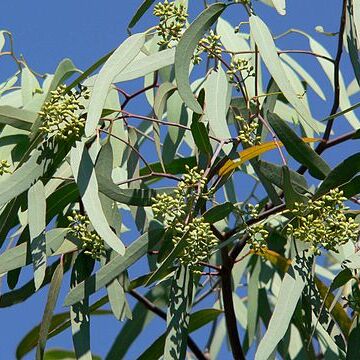Tree to 20 m. Bark varies from smooth and white or grey throughout to rough, fibrous, grey to grey-black on trunk and often on larger branches. Juvenile leaves alternate, lanceolate to broadly lanceolate, green to grey-green or glaucous, slightly discolorous. Adult leaves lanceolate or narrowly lanceolate, acute; lamina 8-17 cm long, 0.8-2.5 cm wide, dull, green or grey-green; lateral veins clearly visible, at 35°-60°; intramarginal vein up to 1 mm from margin; petiole terete, 8-17 mm long. Umbels 7-flowered; peduncle terete, 3-9 mm long; pedicels 1-4 mm long. Buds usually ovoid, occasionally fusiform, often glaucous; operculum hemispherical, apiculate, or conical, 1-2 mm long, 2-3 mm wide; hypanthium obconical, c. 2 mm long, 2-3 mm wide. Fruits hemispherical or obconical, 1-5 mm long, 3-7 mm wide; disc very narrow, ascending, or absent; valves 3 or 4, strongly exserted.
Tree to 7 m. Bark rough, fibrous throughout, grey. Juvenile leaves not seen. Adult leaves lanceolate, sometimes falcate, acute; lamina 7–16 cm long, 1.5–3 cm wide, grey-green or subglaucous; lateral veins clearly visible, at 50°–60°; intramarginal vein up to 2 mm from margin; petiole terete, 5–10 mm long. Umbels 7-flowered; peduncle terete, 5–10 mm long; pedicels 1–3 mm long. Buds obovoid to pyriform; operculum saucer-shaped to almost hemispherical, 1–2 mm long, 3–4 mm wide; hypanthium ovoid to obconical, 2–3 mm long, 3–4 mm wide. Fruits subcampanulate or suburceolate, 3–5 mm long, 2–4 mm wide; disc very narrow, level; valves 3 or 4, included.
Tree to 20 m with bark rough throughout, grey to grey-black.. Juvenile leaves lanceolate; adult lanceolate, 8–17 cm long, 0.8–2.5 cm wide; petiole terete, 0.8–1.7 cm long.. Umbels 7-flowered, arranged in terminal panicles; peduncle terete, 3–9 mm long; pedicels 1–4[5] mm long.. Buds usually ovoid or sometimes fusiform, often glaucous; operculum hemispherical or conical, 1–2 mm long, 2–3 mm wide.. Fruits shallowly hemispherical to obconic, 1–5 mm long, 3–7 mm wide with or without a very narrow ascending disc; valves 3–4, strongly exserted.
A medium to large tree. It is often sprawling. It grows 10-20 m high and spreads 8-15 m wide. The bark is dark grey and fibrous. This extends to the upper branches. The leaves are grey-green. They are 15 cm long and narrow. The small buds are only 3 mm long and wide. They have a whitish coating and a cone-shaped cap. They occur in clusters. The flowers are white. The capsules are funnel-shaped and 4 mm long.


